Cycling Slovenia’s Alpine region is a road cyclist’s dream: think quiet roads, cobbled climbs, dramatic mountain peaks and glacial lakes.
The whole area has that sense of being a bit undiscovered and new, especially compared with the familiar mountain cycling heartlands of France, Italy and Spain.
We’ve written this guide to help you plan a cycling holiday to Slovenia’s Julian Alps. You’ll find everything from the best towns to base yourself in, routes to ride, bike hire and when to go. Enjoy!
This article includes details of products and/or services that we have used ourselves or which we would consider using. Some are paid features or include affiliate links where if you click on a link and make a booking or buy something, we may earn a commission. As an Amazon Associate we earn from qualifying purchases. Please read our disclosure policy for further information.
Note: we refer to Slovenia’s Julian Alps and Slovenian Alps interchangeably within this guide.
All metrics in this article are approximate.
Why are Slovenia’s Julian Alps great for cyclists?
Come to this part of Slovenia to experience challenging riding, untouched nature and ecotourism done properly.
They may not be famous, but climbs like the Vršič Pass and Mangart’s Saddle are up there in terms of providing a big workout amid a pristine mountain backdrop. By way of example, Mangart’s offers up a 10km long ascent with nearly 1,000m of climbing (average gradient of around 8.8%).
The mountain scenery is hugely impressive. We found towering rock cliffs reminiscent of the majesty of the Dolomites, while the wildflower meadows that border many sinewy mountain roads felt a bit like Austria or Switzerland. Meanwhile in the steep green valleys we came across huge lakes and bright green, emerald rivers of a jaw-dropping standard of beauty.
While you wouldn’t choose to go cycling in the Slovenian Alps if you wanted to avoid climbing, there are valley options for easier days. The country’s commitment to good quality, asphalt bike paths is notable. We also found well-thought out facilities for cyclists, with plenty of hotel owners enthusiastically embracing the national bike-friendly accreditation scheme (more on that below).
First, a bit on the layout of Slovenia…
This chicken-shaped country is nestled in the north of the Balkan region. It measures around 250 kilometres east to west by 160 kilometres north to south at its extremities.
Ljubljana, the capital and major gateway for international air travel, sits near the centre of the country. This makes travelling between different regions relatively straightforward and quick.

… and where are the Slovenian Alps?
The Julian Alps are around 70 kilometres northwest of Ljubljana, in the corner that borders Italy and Austria. Look for Mount Triglav on the map and you’ll be in the right area.
The Eastern Julian Alps form a C-shaped range separating the Radovljica and Tolmin municipalities, which encircles the Bohinj Valley and includes the peaks of Mount Triglav (2,864m), Veliko Špičje (2,398m) and Vrh nad Škrbino (2,054m).
Mount Triglav towers above the Julian Alps, the highest mountain in Slovenia and the pre-eminent symbol of the Slovene nation. It is the centrepiece of Triglav National Park, Slovenia’s only national park.
Cycling routes in Slovenia’s Julian Alps
The main bases in the Slovenian Alps for cyclists
Kranjska Gora
40 kilometres northwest from Bled is Kranjska Gora, a beautiful town and a municipality on the Sava Dolinka river. It is best known for winter sports. Every year it hosts an event in the Alpine skiing World Cup series. Mountain biking is big here; there are 150km+ of trails and a bike park.
It offers a good place to access the Triglav National Park and the option to cycle over the Vršič Pass to the Soča Valley. Here you’re just a few kilometres from both the Austrian and Italian borders.
Lake Bled
Just 55 kilometres from Ljubljana, Lake Bled sits at the southeast corner of the Triglav National Park.
Overlooked by Bled Castle and with the Pilgrimage Church of the Assumption of Maria on a small island in the lake, it is one of the most well-known and most photographed Slovenian landmarks.
Lake Bohinj
30 kilometres southwest of Lake Bled, about half way between Bled and Kobarid, you find the lovely Lake Bohinj.
It’s Slovenia’s largest lake and it’s quieter and got less buildings around it than Lake Bled. There’s a cycling path down one side of it, a walking path all around it and tons of watersports available on it.
Soča Valley
West of Kranjska Gora and Bled, on the other side of Mount Triglav, you find the Soča valley. Its towns of Bovec and Kobarid are a mecca for kayakers and adventure sports enthusiasts.
The area also offers some spectacular possibilities for road cyclists, from the stunning Alpine engineering of the Mangart’s saddle to the sinewy border road from Livek to Smartno where you can visit the open-air World War I museum with its restored trenches as well as beautiful cycling in the Brda region.
 Lake Bled
Lake Bled Kranjska Gora
Kranjska Gora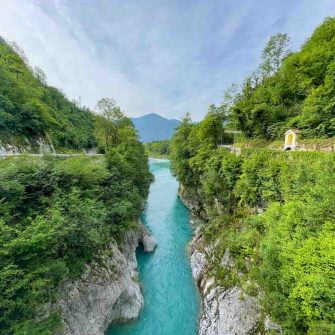 River Soča
River SočaBest-known cycling climbs in the Slovenian Alps
The two most famous road cycling passes in this area of Slovenia are the Vršič Pass and Mangart’s Saddle.
Vršič Pass tops out at 1,611 m and links the Sava and Soča valleys. It is the highest mountain road pass in Slovenia and from Kranjska Gora it’s just over 10 kilometres long (6.9% average gradient). It has a tragic history, unusual cobbled bends and towering limestone pillars that are reminiscent of the photogenic passes of the Italian Dolomites.
Mangart’s Saddle is a dead-end road with stats that are even more eye-popping than the Vršič Pass: also 10 kilometres, but gaining 950m of elevation giving it an average gradient of 8.8%.
You can tackle these beasts on routes 1 and 6 below.
Must-do cycling routes in the Slovenian Alps
The road cycling routes below are based around the three areas of Kranjska Gora, Lake Bled/Bohinj and the Soča Valley mentioned above.
As with many cycling destinations in the high mountains, loop rides are limited unless you’re willing to clock up some serious distance and climbing.
The point-to-point ride through the Julian Alps, mentioned below could be of interest if you’re happy to arrange luggage transfer. Get in touch with the bike hire agencies mentioned below to help with this.
This multi-day, self-guided bike tour that reader John Vincent wrote about, might also be useful.
Kranjska Gora
1. Vršič Pass
12 kilometres, 800m ascent
Summary: a testing climbing with cobbled corners, impressive views and the Russian Chapel.
The route starts in Kranjska Gora in the Sava valley on the north side of the pass. From the town, the road winds south around Jasna lake and after a gentle start the road crosses the Pišnica river again and kicks up to 9% as you reach bend 1, the first of the cobbled hairpins.
The 50 bends are numbered from the Kranjska Gora side, with 24 of them to the summit and 26 on the Trenta side. The climb starts in beech woods and by the time you reach the tightly packed cobbled bends 5 to 9 the gradients hit 15%.
Russian Chapel
Above bend 8 sits the Rusca Kapelica (Russian Chapel). During World War I, the Austro-Hungarian built the pass road to supply their forces on the Isonzo Front. The road was built and maintained by Russian prisoners-of-war as forced labour. In March 1916 an avalanche buried one of these camps killing around 400 prisoners and 10 of their guards. The pass road was renamed the Russian Road in 2006 to commemorate the tragedy.
Bends 10-16
After a brief respite in the gradients, bends 10 to 16 come thick and fast with sections of 12% and 13%. At this point the magnificent limestone pillars become more visible all around. Bend 17 is photogenic, with the 180 cobbled hairpin in forest with craggy limestone cliffs behind.
Summit
After bend 24, there’s a final sting in the tail before the road levels off at the summit of the pass. From the pass, take the small climb on a side-road to the Postman’s Lodge to look out for Ajdovska deklica, the stone face of the Pagan Girl in the limestone rock.
Notes
You can ride this (as most people do) up-and-down from Kranjska Gora.
For a longer ride and to climb and descend both sides, ride over the pass towards Trenta on the south side before returning to Kranjska Gora over the pass.
A note on road surfaces: the Trenta side of the pass is steeper than the Kranjska Gora side and better surfaced (without the cobbled corners of the Kranjska Gora side). For this reason, climbing from Kranjska Gora and descending to Trenta is the ideal way to ride Vrisc Pass.
If you fancy an all-day ride (around 87km and 2,100m of climbing), follow the Soca valley to Kal Koritnica before heading north to Zakriž and looping back to Krajska Gora via Travisio in Italy. Here’s a GPX with an example route – we haven’t ridden this.
 Roughly one third of the way up the Vrisc Pass
Roughly one third of the way up the Vrisc Pass  Evening light on the Russian Chapel in a small clearing on the Vrisc Pass, just after a rain storm
Evening light on the Russian Chapel in a small clearing on the Vrisc Pass, just after a rain storm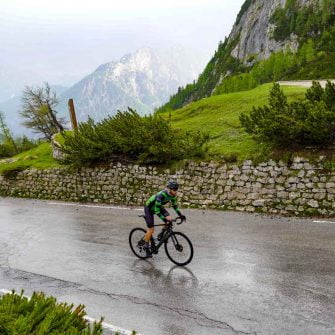 A damp experience of the summit at the Vrisc Pass!
A damp experience of the summit at the Vrisc Pass!2. Kranjska Gora to Bled (valley cycle route)
With a few edits, if your Slovenia cycling holiday is based out of Kranjska Gora, you could ride the route we’ve suggested at route 5 below from Kranjska Gora to Bled instead.
Lake Bled / Lake Bohinj
3. Loop of Lake Bled and Lake Bohinj from Ribno
66 kilometres, 1,200m ascent
Summary: one big climb, two stunning lakes, meadows and pastures galore
From Hotel Ribno, the route sets off through villages and fields to meet Lake Bled. You snake around the west side of the lake and past the rowing centre, which has hosted the World Rowing Championships. You follow and cross the railway before peeling westwards towards Zgornje Gorje as the climbing starts.
Krnica
After leaving the village of Krnica you enter the forest and the more serious gradients kick in, with several kilometres averaging 10% and topping out over 14% on the winding forest road. At Zatrnik the views open up over meadows and the road flattens out momentarily at an old Alpine ski centre.
Quickly the climbing resumes with three kilometres through the Alpine ski mecca of Pokljuka, Slovenia’s foremost cross-country skiing resort which annually hosts the Biathlon World Cup. Leave the 905 and follow the road right to Rudno polje and you find yourself on a dead straight, flat road that dissects thick pine forests. If it looks familiar, it is frequently used for drone shots for car adverts!
Pokljuka Plateau
After another few kilometres, take a left on a single-track road signposted to Sport Hotel Pokljuka. Over the coming roads, beware dozy cows which have come up the mountains for their summer season!
From here, most of the climbing is done. The thick pine forests and wooden mountain huts of Goraljek give way to open meadows (May/June is the best time to enjoy the wildflowers) and glorious views to the southern peaks of the Triglav National Park. These small roads have some steep and narrow sections – beware of gravel and blind corners.
Cycling Lake Bohinj
At Jereka you join the valley road and pass through villages and fields lined with hayracks, before you appear at the famous bridge of Lake Bohinj, with the stunningly beautiful basin of the Triglav mountain range encircling its western end facing you. Over the bridge, you can make an optional detour right (along the southern side of the lake) to visit the Savica Waterfall. This also adds about 20 km and an easy climb before the waterfall.
Return to Bled
After leaving Lake Bohinj the valley road takes you steadily downhill all the way to Bled. First you come to Bohinjska Bistrica, a few kilometres from the lake, before following the river through Nomenj and down to lake bled, before retracing back to Hotel Ribno.
Note: we didn’t ride the section from Lake Bohinj ourselves, as we headed over to Kobarid for the next part of our trip.
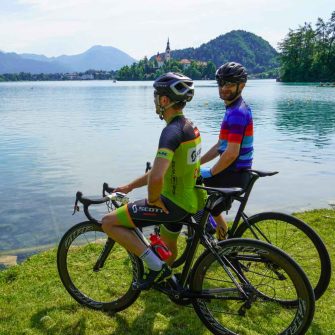 Can we go now?!
Can we go now?! Views from above Lake Bled
Views from above Lake Bled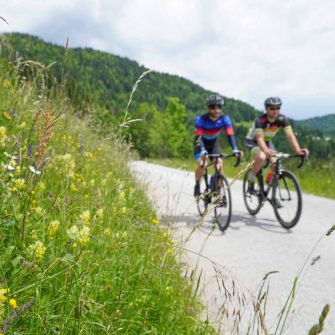 We’ve never seen wildflowers like the ones we saw in Slovenia; absolutely incredible
We’ve never seen wildflowers like the ones we saw in Slovenia; absolutely incredible4. Ribno to Kobarid via Bohinj
112 kilometres, 2,400m ascent
Summary: Like route 3, but adding in another pass and a cracking (mainly) descent to lovely Kobarid
The route follows the same roads as the Lake Bled and Lake Bohinj loop as far as Bohinjska Bistrica, after Lake Bohinj.
Bohinj Saddle climb
From here you peel off right to add another solid climb up to the upper Bohinj Valley. For almost 12km you climb through meadows and forests on a quiet road, before taking a right signposted to Tolmin and the Soriška planina ski resort. The last 4km are particularly brutal, averaging around 8.5% before the road plateaus out at the wide road around the mountain centre.
Tolmin
From here, you’re descending down the valley road towards Tolmin for over 25km. For the upper section, through Zgorna Sorica and Petrovo Brdo, you enjoy twisting forest roads and the occasional expansive view of mountain peaks.
After Trtnik the downhill continues but less steeply, following the rocky Bača river valley and then skirting into the Soča valley to reach Tolmin.
Soča Valley
From here you first glimpse the fabled and striking emerald waters of the Soča river, before arriving in the charming, buzzing town of Kobarid.
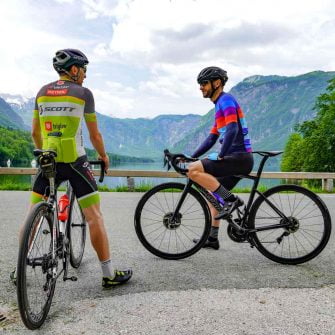 At Lake Bohinj
At Lake Bohinj Wildflower meadows abound
Wildflower meadows abound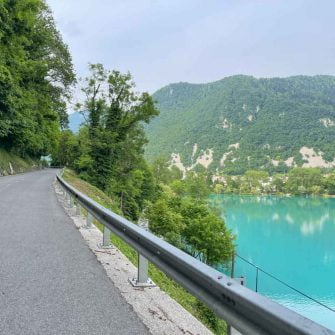 The incredible water in the Soca Valley
The incredible water in the Soca Valley5. Ribno to Kranjska Gora loop (with Planica extension)
96 kilometres, 1,200m ascent
Summary: a flexible ride that which you can extend or reduce as you feel; a good option for a rest day ride
From Hotel Ribno, the route heads through villages and fields to Lake Bled. You follow the west side of the lake and pass the rowing centre, crossing the railway and climbing up to Gorje and Krnica.
Radovna Valley Road
From here you join the sparsely populated Radovna valley road through beautiful forests and fields. The Radovna river is reputed as the most beautiful and cleanest river in the Gorenjska region, and also supplies all Bled with drinking water.
The climbing is steady until Zgornia Radovna, when the sign ominously marks 18%, but the steepest section is over quickly. After the climb, descend quickly to the valley road at Mojstrana, where you can find the Slovenian Alpine Museum. Mojstrana was the starting point for the first mountaineers who conquered Mount Triglav in the year 1778.
Valley cycle track
From Mojstrana, the route continues along the paved off-road cycling track for about 20 km through idyllic nature to Kranjska Gora, the mountain venue for the men’s alpine skiing World Cup.
Pick an option
From here you can choose from a number of options:
- A coffee and a head back down the valley on the cycle path to Jesenice, before a short sharp climb from Lipce and cruising back to Bled.
- Continue around 7 km along the cycle path and climb up the valley side to the Nordic Centre at Planica. Perhaps the preeminent venue in the world for ski jumping and ski-flying, it has witnessed dozens of world records and also hosts cross country skiing, ziplining, curling and more. You can even cross-country ski in the summer, in an underground tunnel cooled to -2°C!
- For a more challenging extension, take on the Vrsic pass.
Note
This route was suggested to us by Hotel Ribno; we haven’t ridden it.
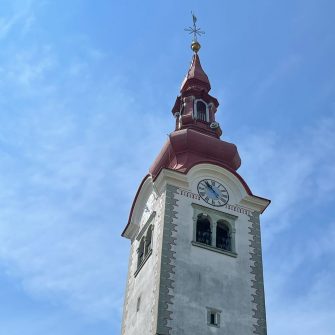 The classic kind of bell tower you see around Lake Bled
The classic kind of bell tower you see around Lake Bled 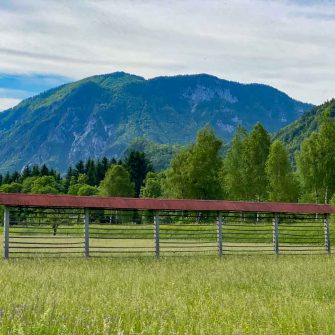 You’ll see these kind of hay racks all around the Lake Bled valley
You’ll see these kind of hay racks all around the Lake Bled valley The first time a cycling path is so impressive it’s made us stop to take a photo
The first time a cycling path is so impressive it’s made us stop to take a photoKobarid
6. Kobarid to Mangart Saddle
47 kilometres, 2,200m ascent
Summary: a 30km warm up followed by a testing challenge up to Mangat’s Saddle (if it’s open!)
Warm up from Kobarid
From Kobarid, you take the narrow road above the beautiful Soča river. After a few kilometres on this small road, you join the main valley road to Žaga.
A few kilometres after Žaga, turn off at the sharp left and cross the vertiginous bridge over the river onto a wooded road by the river, which opens into meadows.
After passing the village of Čezsoča, you once again join the main road at Bovec, rising gradually up the wooded valley for another 15km, with the last 5km averaging around 8% and glimpses appearing of the glorious craggy peaks.
Base of Mangart’s
Several kilometres after Strmec na Predelu, you reach a bridge on the 203 and the Mangat’s Saddle road (route 902) appears on the right, an unassuming singletrack with a small parking area and a picnic bench. From here, the real climb of Mangat’s Saddle starts and straight from the gun, you hit gradients of 15% in the narrow rocky valley with a limestone pillar in the distance indicating what’s to come.
Tunnels, road tolls and climbing
After the first looping switchback you climb directly up the valley over barren rocky landscape, reaching a road toll as you enter the forest after around 2km of the climb.
The road is narrow and the trees mask the climb to come. After around 4km you reach the first tunnel – lights required!
The next three tunnels follow on soon afterwards and you start to get a sense of the awe-inspiring scenery – a 360 degree landscape of craggy limestone. As you climb higher, the hairpins give views backwards down the lush green valley and to more distant peaks, before turning again to the sheer rock faces.
After the fifth tunnel, the road snakes round the wide bowl of the valley, reminiscent of the southern side of the Gavia Pass in Italy, with a short kicker of over 20% as you approach the summit. A nondescript parking spot with barely a small car park, sign or picnic spot marks the summit of this majestic climb.
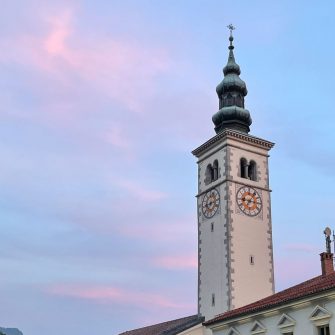 Beautiful church tower in Kobarid
Beautiful church tower in Kobarid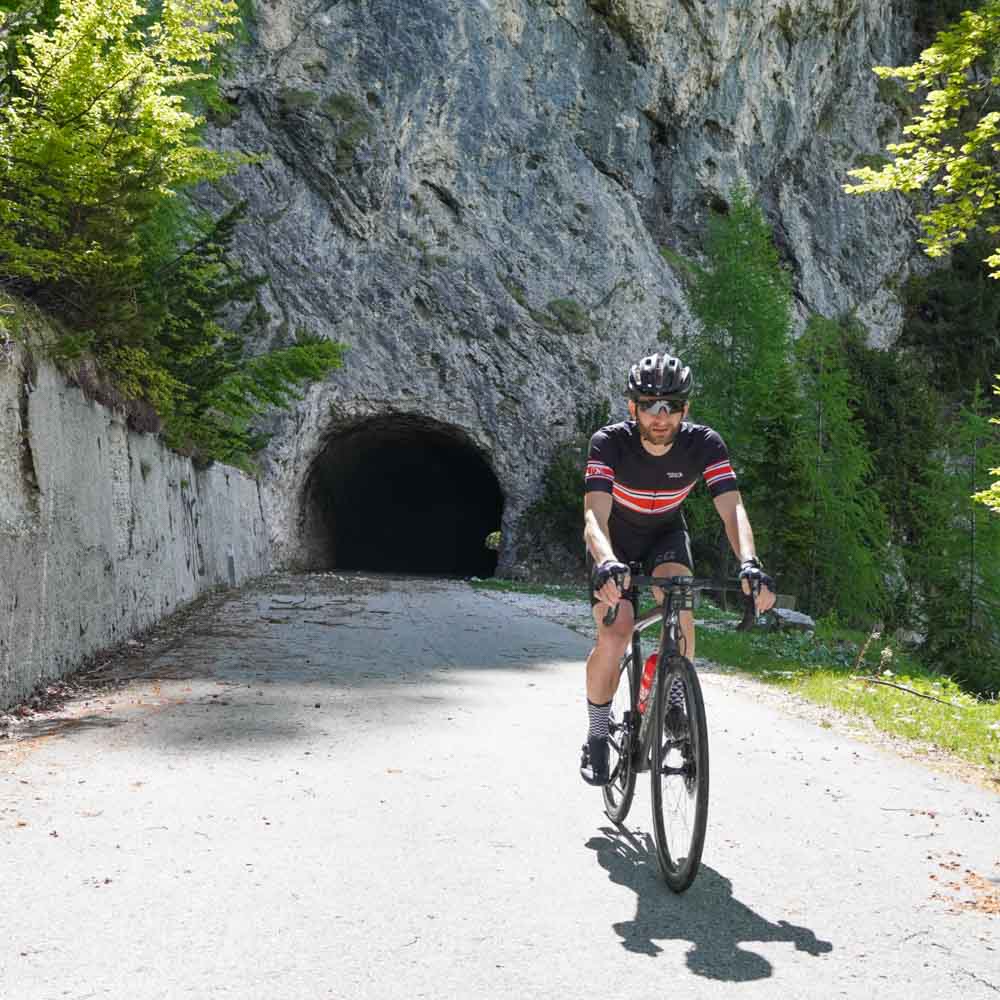 Dark tunnels are a feature of this climb; bring lights
Dark tunnels are a feature of this climb; bring lights Debris in a tunnel on Mangart’s Saddle climb!
Debris in a tunnel on Mangart’s Saddle climb!History
Route 902 is the highest road in Slovenia, reaching an elevation of 2072m. It was built by the Italian army in 1938 to help defend against the Yugoslav army. The road climbs over 1,000m in less than 12km. Beware those with vertigo as protection is limited and the road can get busy with tourists in the summer.
Snow closures
The road is generally open May to September, with the exact dates dependent on snow conditions.
When we visited in mid-June, a heavy winter snowfall had closed the road. Ever ambitious, we pedalled on, unclipping to cross numerous snowdrifts, pitch-black tunnels with rockfalls before reaching metres-high snow completely covering the last of the five rock tunnels at around 1,800m altitude. So we didn’t get to taste the steepest upper section that is marked as reaching over 25%!
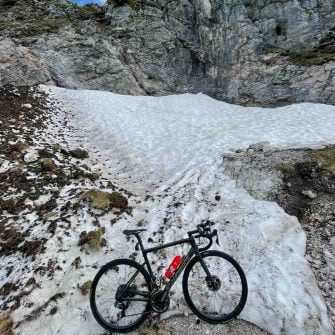 Mid June. They said the road was still blocked by snow – and they were right… There’s a tunnel behind this lot (apparently!)
Mid June. They said the road was still blocked by snow – and they were right… There’s a tunnel behind this lot (apparently!) Time for a photo stop!
Time for a photo stop!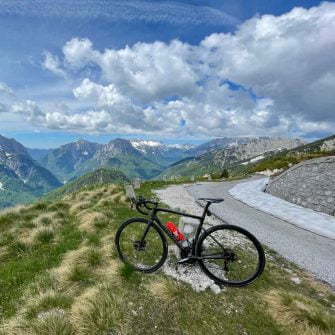 Views from Mangart’s Saddle (as high as we could go on Mangart’s anyway!)
Views from Mangart’s Saddle (as high as we could go on Mangart’s anyway!)7. Kobarid to Smartno loop
98 kilometres, 2,400m climbing
Summary: a gorgeous, tranquil ride to the Brda region with a testing first 15 kilometres
From Kobarid, head south on the route 102 valley road. Barely two kilometres and you take a right turn in Idrsko, signposted to Livek. The wooded road masks what is to come but soon you get the idea!
Climbing to Liveske Ravne
For the next 5 kilometres you’re averaging a lung-busting 10%, with some sections considerably steeper. You’ll need all your gears for this one! The valley falls away behind you as the road snakes upwards and soon enough the wooded roadsides open up on mountain meadows and the cluster of houses of Livek. The road levels off through the Livek but this respite lasts barely 500m.
After a left turn in the centre of Livek (signposted Kambresco / Livske Ravne), the zig-zags start quickly on the next round of climbing, this time an average of around 9% over 5km. After Livske Ravne the trees open up a little and after another 1.5km you crest the climb, as the road runs very close to the Italian border.
Before the proper descending starts you pass the excellent Open-Air World War I Museum, which is well worth a visit to see the preserved open trenches. From here you descend gradually to Kambrešco, before climbing gradually, all on small roads through lush green landscapes.
Lig and the “Tuscany area of Slovenia”
After Lig, you take a tiny road that climbs gradually through forest before you emerge to a whole new scenery. You quickly understand why the Brda region is known as the Tuscany of Slovenia, with vineyards, rolling hills, hilltop churches and the land that drops away towards the Adriatic sea. After rounding one such hilltop, a long descent follows to the main road and Smartno.
From Smartno, you have a few options for your cycling route back to Kobarid:
- You could follow the same route back to Kobarid for an out-and-back.
- You can follow the road down to the valley at Plave and follow the Soča river all the way back to Kobarid. For the upper valley (Plave to Kana lob Soči) you can detour the main route 103 valley road, but after this you will need to follow this busier, faster road all the way back to Kobarid.
- The final option (and our suggestion) would be to head west from Smartno on route 402 and cross into Italy. We haven’t ridden this route but it looks a great option, climbing steadily on small roads before climbing up to the border around Livek before retracing the route back to Kobarid. We understand that border checks are not generally undertaken on cyclists, but we’d recommend slipping your passport in your jersey pocket (well tucked, in a ziplock bag!).
 View near Liveske Ravne
View near Liveske Ravne Lunch at Hotel San Martin is reason enough to do this ride!
Lunch at Hotel San Martin is reason enough to do this ride!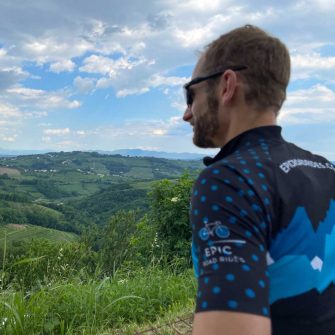 Rolling hills and pretty villages; a ride in the other direction from Kobarid looks quite different!
Rolling hills and pretty villages; a ride in the other direction from Kobarid looks quite different!8. Tour of the Julian Alps, Slovenia
A final thought – if you’d prefer to do a multi day point to point tour, Slovenia Outdoor have provided us with this GPS route which takes you on a 324 kilometre loop of the region. There’s more information on it in our pick of the best cycling routes in Europe.
Tips for riding in this area
Many routes in and around the Julian Alps criss-cross into Italy and sometimes Austria (two Schengen areas). We have it on reliable authority that cyclists are not checked, but we’d suggest taking your passport just in case if you’re looping through another country.
Check out our tips for cycling in the Alps article for general tips on riding in the high mountains; many will be relevant to cycling in the Julian Alps too.
EuroVelo routes in Slovenia
Heading beyond the Slovenian Alps for a moment, there are three EuroVelo routes in Slovenia, EuroVelo 8 (Mediterranean Route) (read more here), EuroVelo 9 (Baltic-Adriatic) and EuroVelo 13 (Iron Curtain Trail).
EuroVelo 8 and 13 are already signposted. EuroVelo 9 is under development.
In addition, there is Eurovelo Sava. This is signed but also under development. It runs along Sava river from Kranjska Gora (where is connected with Tarviso in Italy) to the Croatia border near Zagreb.
The Drava bike route is also very well known. It starts in Austria at the source of Drava river, passes Maribor, Ptuj in Slovenia and finishes in Varazdin in Croatia.
Road cycling events in the Julian Alps
Pro cycling events
The annual Tour of Slovenia, held in mid-June and dating back to 1993, is the country’s largest event that showcases both domestic and international talent. Other one-day races held in Slovenia include GP Kranj, GP Slovenian Istria and GP Adrian Mobil.
The Giro d’Italia has periodically visited Slovenia. The starting or finishing points of the “Slovenian” stage have included Kranj, Bled, Portorož and Ljubljana, and the route of the Giro has also ventured into the Brda region in the past. In 2021, the 15th stage started in Italy’s Grado and entered Slovenia at Vipolže. After several loops around the Brda region, the stage followed the Slovenian-Italian border to Nova Gorica and across Europe Square to the finish line in Gorizia.
Amateur cycling events
The Juriš na Vršič is an annual timed event up the north side of the Vršič Pass that takes place on the first Saturday in September with a start in Kranjska Gora. This event is an institution for Slovenian amateur cyclists and has run for more than 40 years. The course is 13.5 km long and cyclists climb over 800 vertical metres at an average of over 7% up the cobbled bends of the north side of the pass.
Other Slovenian cycling events include the Istrski Cycling Marathon around Koper in Slovenia’s Istria region. There’s also the Maraton Franja around Ljubljana and the Maraton Alpe in the Kamnik Savinja Alps.
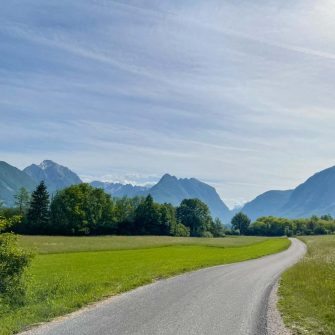 Quiet backroad on the way to Mangart’s Saddle (route 6 above)
Quiet backroad on the way to Mangart’s Saddle (route 6 above) The Tour of Slovenia passed through the Brda region just the day before we were there!
The Tour of Slovenia passed through the Brda region just the day before we were there!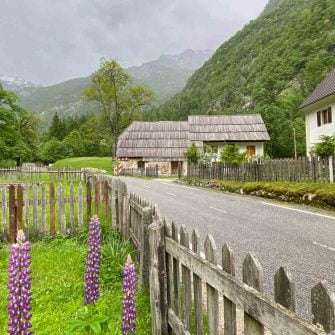 Slovenia: achingly beautiful, even when it rained!
Slovenia: achingly beautiful, even when it rained!Accommodation for cyclists in the Julian Alps
Remember to double-check accommodation bike storage arrangements (and any other services you need) before booking as policies often change.
Cycling-friendly accommodation in the Julian Alps
Slovenia Outdoor operates a system of accredited “Slovenia bike hotels and camps”. This allows accommodation providers to get between one and five bicycle symbols indicating the extent and quality of what they offer cyclists. It’s quite a demanding scheme.
- A one bike hotel provides information on what there is for cyclists in the area and a cycling information point.
- A two bike hotel also has a cycling map of the area, marked local cycle routes, a cycling guide and the option of local bike rental.
- A three bike hotel also provides advice for planning tours, has cycling guides available, provides GPS data for tours and offers at least a 4 day programme of local tours.
- A four bike hotel also provides a 6-day programme of cycling tours and a number of cycling guides. It sells spare inner tubes, offers free transport to service points and replacement bikes.
- A five bike hotel must also employ a cycling guide.
Slovenia bike campsites provide a range of information on cycling in the area, offer a 4-day cycling tour programme and one trained guide.
Check out Slovenia Outdoor’s website for all the cycling-friendly accredited accommodation in the Julian Alps (here).
Where we stayed
Hotel Ribno, Bled
Izletniška ulica 44, 4260 Bled│Website
A member of the RoadBike Holidays network, Hotel Ribno was the most overtly cycling-friendly hotel we visited in Slovenia. From the moment you walk into the reception area, you know you’re welcome since five or more pro jerseys hang on the wall together with Tadej Valjavec’s Tour de France bike.
Matija and Katarina are the dynamic couple behind this hotel. Matija is a passionate cyclist and Katarina told us that he had been dreaming of running a fully bike friendly hotel for many years.
The hotel is in a tiny village about two kilometres from Lake Bled on the edge of a spruce forest. Highlights of our stay included the sunny terrace surrounded by forest and our room on the recently renovated second floor, with its handmade wooden headboard and natural materials. We also appreciate the hotel’s Zero Waste Hotel certificate (the first in Slovenia).
The soon to be completed bike village looks seriously impressive. It will have 17 cottages made of spruce and larch, set between trees, each with its own hot tub and bike storage. We think they will be perfect for cyclists that love nature – and also love luxury! There will be a bike hub within the village with a mechanic and tour guides available throughout the season. Facilities like bike hire, bike service station, bike wash and après ride snack bar promise to be excellent. It was a few weeks off completion when we visited, but if it’s executed nearly as well as the rest of Hotel Ribno, it’s somewhere you should definitely consider staying.
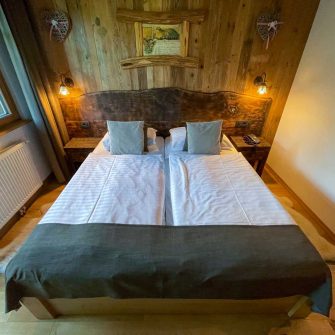 Hotel room at Hotel Ribno
Hotel room at Hotel Ribno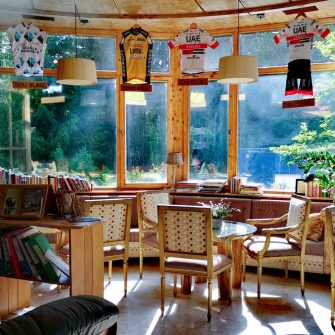 Entrance of Hotel Ribno, with cycling jerseys
Entrance of Hotel Ribno, with cycling jerseys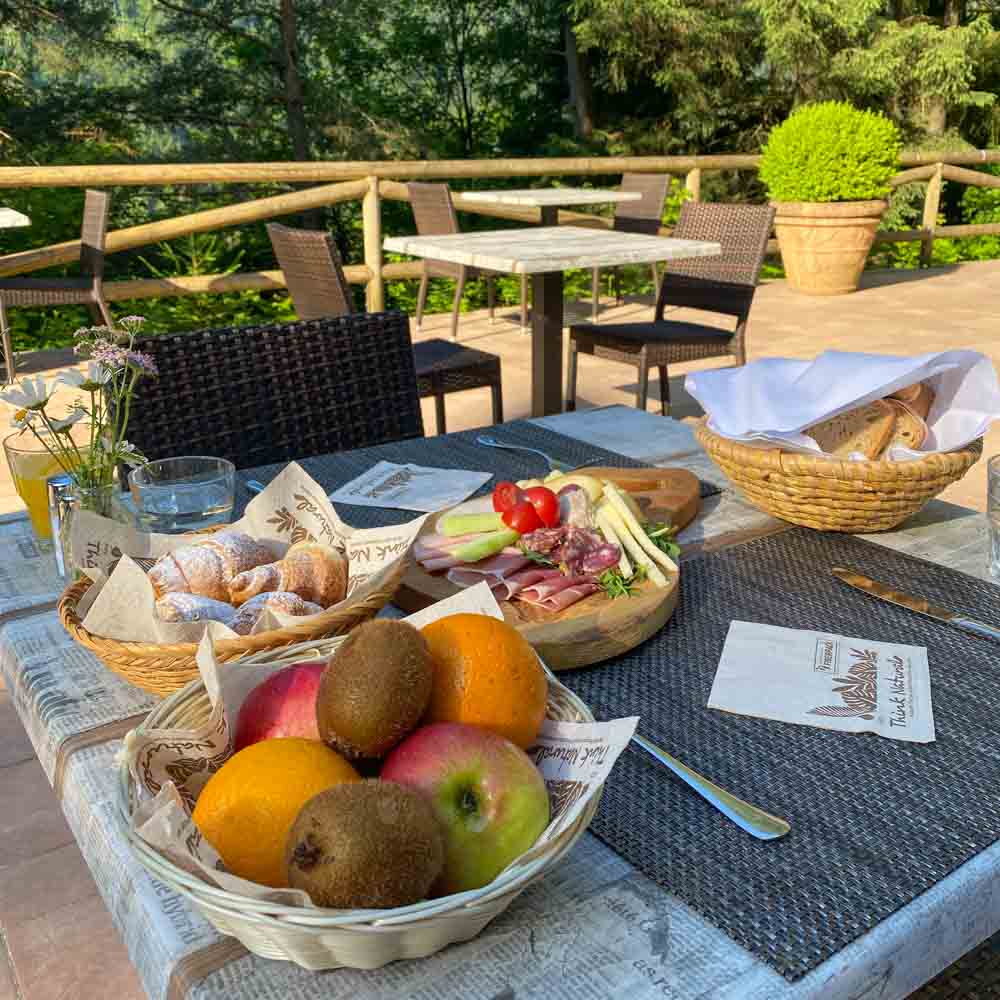 Covid-compliant breakfast at Hotel Ribno
Covid-compliant breakfast at Hotel RibnoCamp Koren, Kobarid
Ladra 1b, 5222 Kobarid│Website
Camp Koren sits above the spectacular Ricer Soča on the edge of the Triglav National Park. At first site it looks pretty simple; a rustic reception desk, small bar and outside seating past which you find at a camp ground. However, looks can be deceiving; this campsite has three accommodation styles and there’s a ton of activities available.
On the accommodation front, take your pick from camping, staying in one of the six cabins for up to 6 people or alternatively one of the new glamping pods. We stayed in a pod and loved the full-length glass window with its view into the forest canopy. There was also a surprising amount of luxury despite it being a small wooden building the width of a double bed.
You’re spoiled for choice with activities: everything from beach volleyball to a climbing tower, gym, sauna and salt room. Onsite kayak rental and tours are also available.
Camp Koren is situated 500 metres from Kobarid, making it easy to pop into the town for a meal or beer in one of its bars. When Covid isn’t an issue, food is also served at Camp Koren and there’s a small onsite shop.
Though there is a bike store, be aware that it is diminutive and, when we visited, was crammed to the rafters with four or five of their rental e-bikes. Camp Koren work with local tour operators to provide additional bike rental and tours.
 Traditional cabins at Kamp Koren
Traditional cabins at Kamp Koren The surprisingly luxurious (and very Insta) glamping pods we stayed in
The surprisingly luxurious (and very Insta) glamping pods we stayed in The rather beautiful gym area
The rather beautiful gym areaChalet Hike and Bike
Stara Fuzina 117, 4265 Bohinjsko jezero│Website
A charming, small chalet in the village of Stara Fuzina, 10 minutes walk from Lake Bohinj. It sits by the side of the Mistnica stream with a lovely garden, grill, sun beds and outside seating.
We didn’t stay here ourselves but it’s got the makings of a great base if you want to stay near Lake Bohink. There are two double bedrooms, each with an additional bed, so the house sleeps a maximum of six.
There’s a lovely garden and a separate outbuilding with bike rack. It’s owned by Grega and Maja, a local couple.
We met Grega over lunch and found him relaxed, fun and extremely knowledgeable about all things cycling and hiking in the area. No surprise really since he also runs the Hike and Bike agency, offering guided cycling tours, bike hire, bike servicing and luggage transfers in the area. More info below.
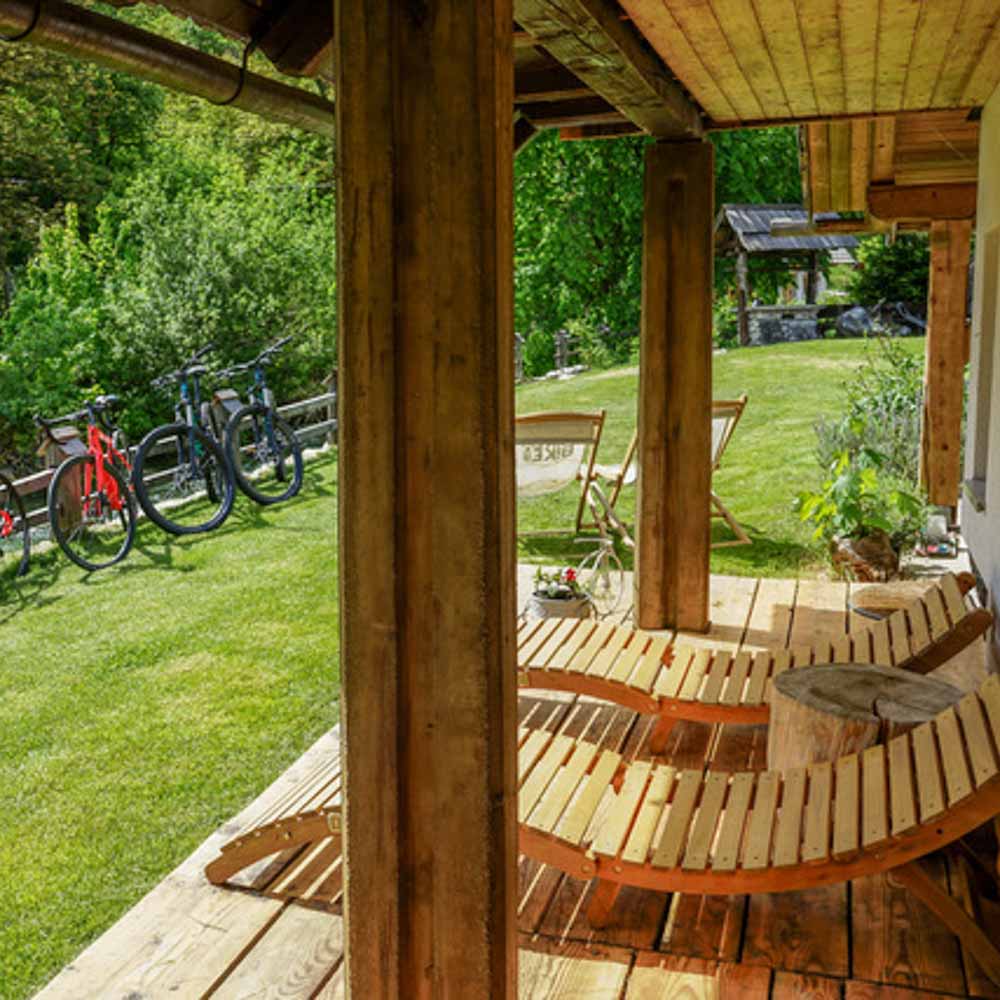 Hike Bike Chalet
Hike Bike Chalet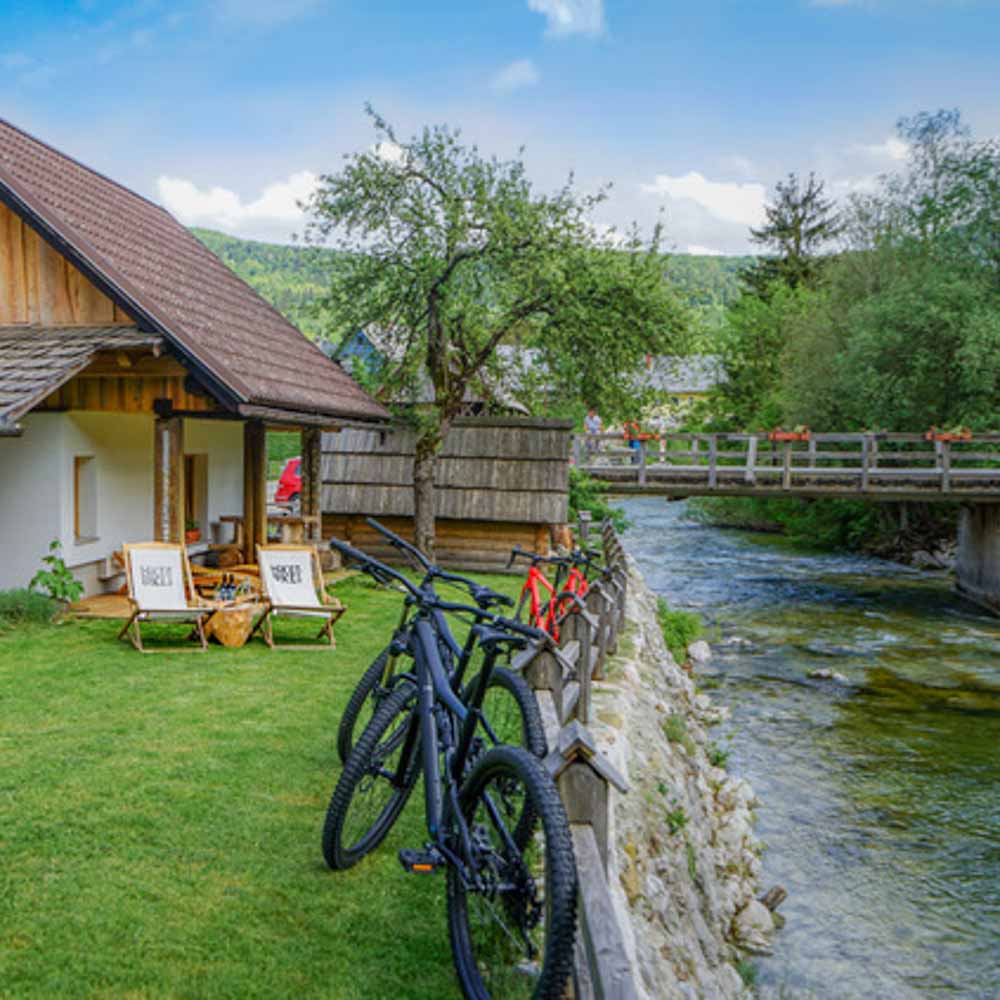 Great garden with outdoor bike storage in background
Great garden with outdoor bike storage in background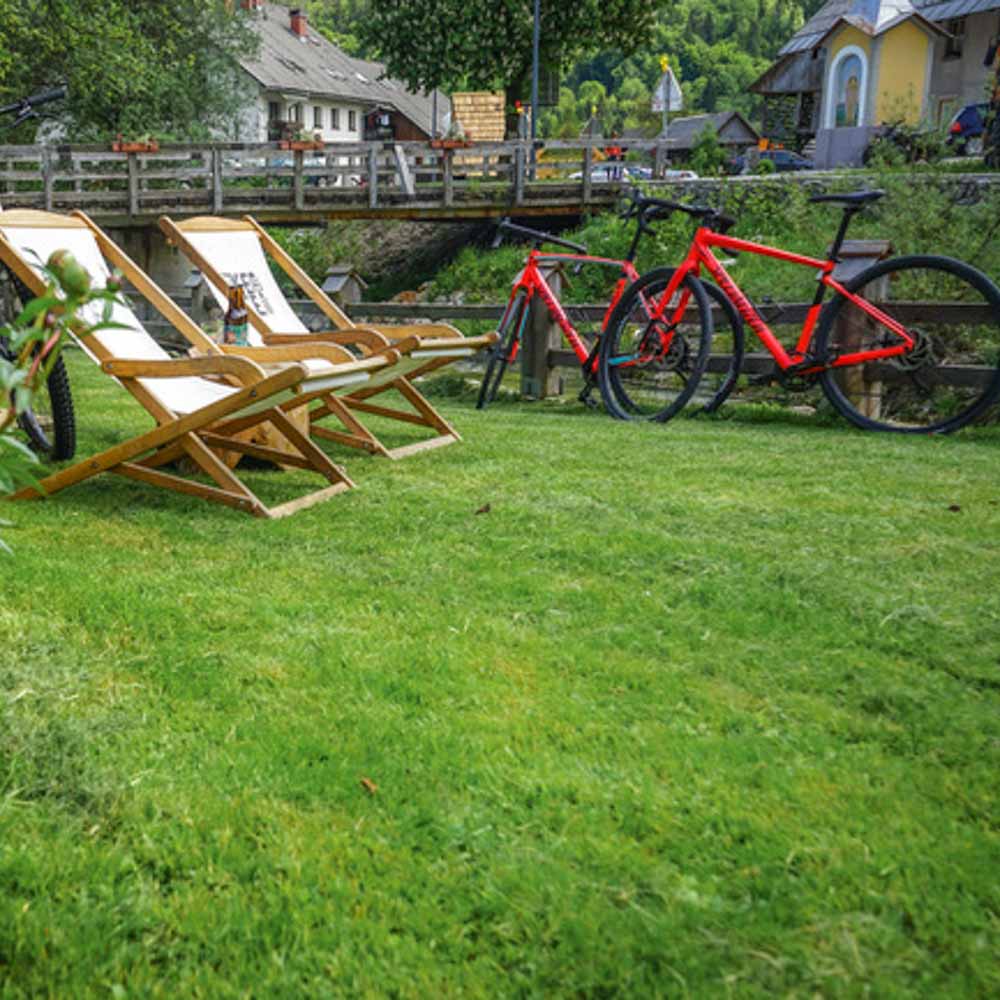 Chill out space at Hike Bike Chalet
Chill out space at Hike Bike ChaletBike rental in Slovenia’s Julian Alps
Prices, services and bike brands often change. Please let us know if anything is incorrect.
While there is an explosion of e-bike and mountain bike hire in Slovenia, we found good quality road bike hire relatively limited. You’ll definitely want to book ahead if you’re planning to rely on road bike rental in Slovenia. If you can’t bring your own bike, we suggest trying the following.
Lake Bohinj bike hire
Hike and Bike Slovenia, Bohinjska Bistrica – provide Specialized Diverge road and gravel bikes.
If you don’t need road bikes, take a look at
- Sport agency PAC
- Camp Danica
- Pension Lajnar, Soriska planina
Lake Bled bike hire
- Rent a bike Slovenia (Helia Travel Agency), Bled – provide Trek road bikes.
- Hotel Ribno (details above)
Other bike hire in Slovenia
Note that these are unlikely to be able to help with road bike rental.
Kranjska Gora
HIT Alpinea – Kompas hotel
Bovec
Hotel Boka
Kobarid
Camp Koren
Positive sport
Tolmin
Hotel Dviorec
Cycling guides/tours in Slovenia
While visiting, we rode with ex pro cyclist Tadej Valjavec who offers road cycling guiding in Slovenia. Tadej is a climber who finished top 10 in three Grand Tours between 2004 and 2009 (the 2009 title was subsequently voided). Tadej rode for 10 years in the pro peloton, with four pro teams including some of the big names of the era like Tyler Hamilton, Floyd Landis, Mario Cipollini and Lance Armstrong. More on Tadej here.
We found riding with him absolutely fascinating; he’s happy to share his experiences of the pro peloton and he came across as being humble, down to earth and generous. He’s also a huge U2 fan! Get in touch with him here.
Many of the bike hire outlets mentioned above also offer cycling guiding; get in touch with them if you’d like more information.
When to go
In Slovenia the climate falls into three prevailing types: Alpine, Continental, and Mediterranean.
In the Julian Alps, you will largely experience the Alpine climate.
May and June
May and June are great months to visit, with river rafting and wildflowers in season. At this time of year you’ll generally find a very pleasant climate. There will be fewer tourists than in the busy summer months although there may well still be snow on the high alpine passes, if indeed they are open. (Check out our experience of Mangart’s Saddle above!)
September
Together with May and June, September is also popular for training camps. For budding botanists, Bohinj hosts the International Wildflower Festival at the beginning of June. Note that the rich and lush flora give an indication of the sometimes heavy rainfall in the region.
July and August
If you want to experience the short season of lake swimming at Bled and Bohinj (and don’t have a wet suit or arctic experience!), July and August are the optimum months. In terms of road cycling, be aware that roads will be busier, and it is recommended to start early to avoid the scorching middle-of-the-day temperatures.
November to April
From November to April, temperatures will not make for pleasant road biking, the higher passes will be closed and skiing will dominate in favour of cycling.
If you’re looking for a longer cycling season, to the south of the Triglav National Park, the Mediterranean coast area (including the Karst and Slovenian Istria) benefit from the warm sea air and higher temperatures than the rest of Slovenia.
 Beautiful day in June looking over Lake Bohinj
Beautiful day in June looking over Lake Bohinj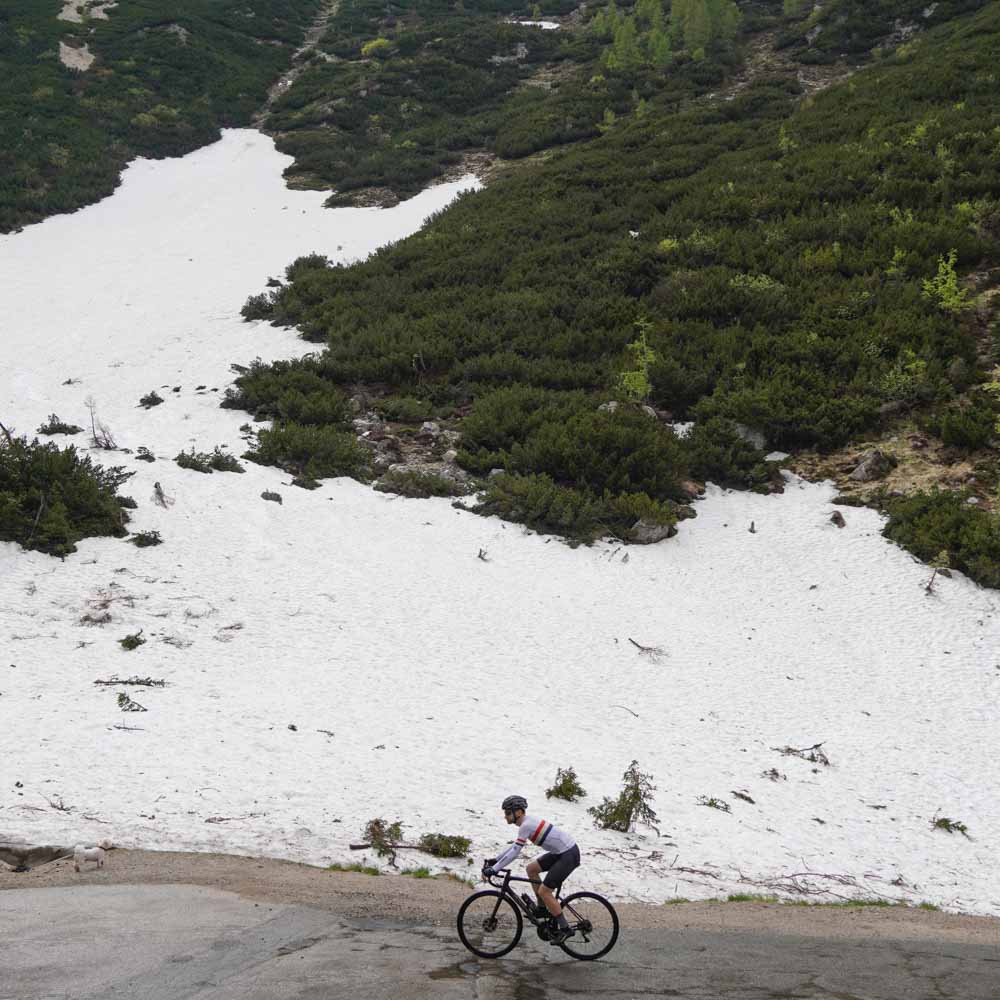 Snow on Vrisc Pass in June
Snow on Vrisc Pass in June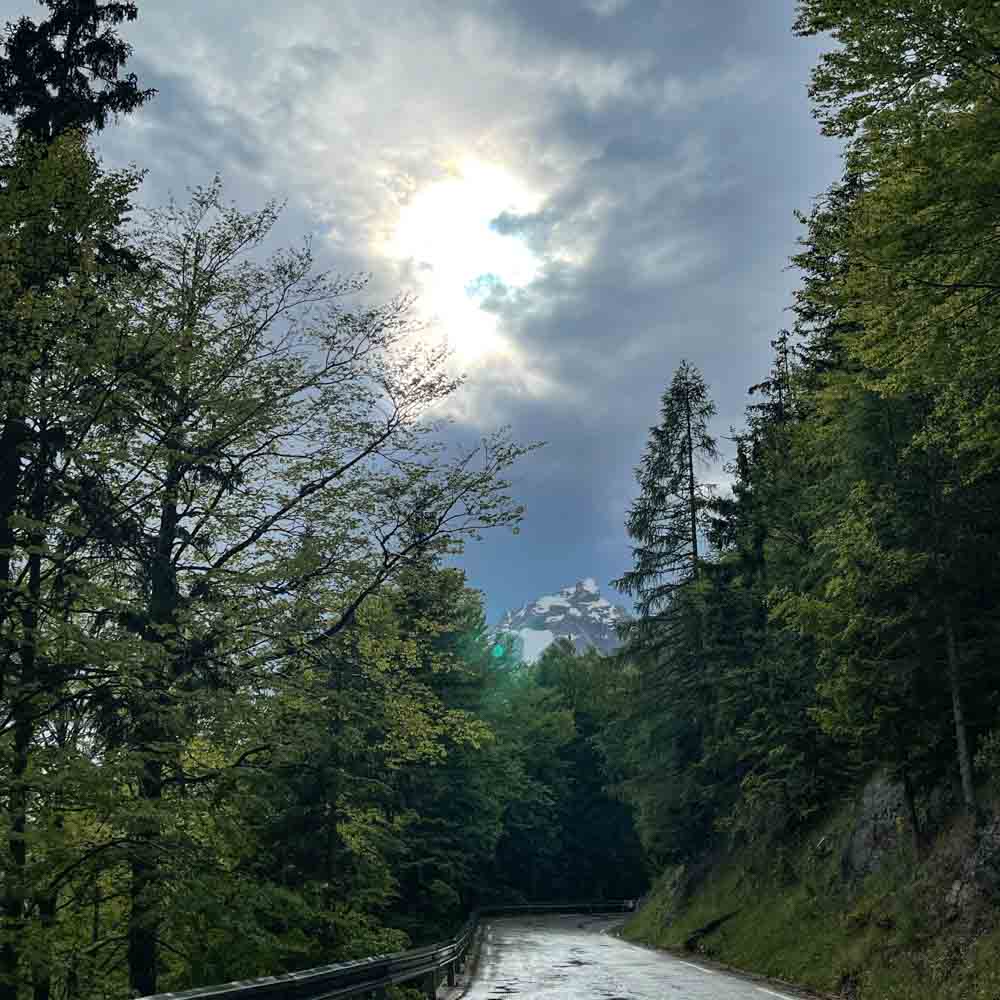 Rainy few hours in June – sunshine followed this rainstorm!
Rainy few hours in June – sunshine followed this rainstorm!Tips for planning your Slovenian bike trip
A (very quick) Slovenian history lesson
Slovenia is a young and vibrant country of 2 million people, which gained its independence in 1991 (before that it was a state of the former Yugoslavia). Slovenia joined the European Union in 2004
Slovenia borders Austria, Croatia, Hungary and Italy. Slovenians are both fiercely proud of their heritage and embrace their membership of the European bloc. By way of illustration, Gorica and Gorica Nova, two interconnected cities that straddle the Italian/Slovenian border, will jointly host the European City of Culture in 2025.
Slovenian cyclists in the spotlight
Slovenia has often had representatives in the professional peloton, but since 2017 the country shot to fame with Primož Roglič, Tadej Pogačar and Matej Mohorič flying the Slovenian flag at the very upper echelons of the sport.
2020 was the pinnacle of Slovenia’s pro cycling success, with an unprecedented win and runner-up place in the Tour de France for Pogačar and Roglič respectively. In a Hollywood-style finale, Pogačar snatched the victory in the stage 20 time trial, the last gasp of the three week Tour before the Paris procession.
Slovenian cycling fans explained to us how they were emotionally confused when Pogacar (a younger, strong and exciting new prospect) surpassed Roglic (the country’s cycling darling) to claim cycling’s most prized crown.
Ecotourism in Slovenia
While many destinations are now pushing to burnish and publicise their ecotourism credentials, in Slovenia it is neither new nor forced. Their slogan “Fight for Green” really seems to permeate this green country.
Every Slovenian we met spoke passionately about how their culture, traditions and livelihoods are inextricably intertwined with the beautiful natural environment that surrounds them.
Slovenia has a rich history, culture and artisanal traditions, such as the distinctive hayracks that dot the fields of the country. They’re used by families to dry the hay from their field; we were told that in the region we visited, it’s normal for every family to have a second job that involves small scale agriculture, whether that’s growing their own vegetables or owning a few cows and growing the hay for them in the fields. This is agriculture on a micro level.
Slovenia’s natural beauty spans the breathtaking emerald green of the Soča river in the west to the Pannonian plain in the east. Almost half of the country is forest. People here seem to love the outdoors and being active is a way of life for much of the nation. No wonder the country punches well above its weight in sports as diverse as cycling, cross country skiing, basketball and rowing.
 Did we mention the wildflowers?!
Did we mention the wildflowers?! Walking the walk at Hotel Ribno
Walking the walk at Hotel Ribno Small, traditional farm buildings still in use by local farmers near Bohinj
Small, traditional farm buildings still in use by local farmers near BohinjCycling maps of Slovenia
Slovenia Outdoor is an enthusiastic proponent of cycling and cycling holidays. We recommend taking a look at their website and their high quality cycling maps and brochures that are available in tourist offices in Ljubljana, Bled, Kranjska Gora or other major towns.
What to bring for a cycling trip to Slovenia
In terms of cycling kit, the usual guidelines apply for cycling in high mountain and with changeable weather and temperatures.
Appropriate gearing and some training are recommended!
More detailed suggestions here.
Does everyone speak English?
Everyone we met had a reasonable (to excellent) grasp of English. People were unswervingly friendly, helpful and hospitable.
Rules of the road
Before you go, familiarise yourself with Slovenia’s rules of the road for cyclists.
A few other notes and thoughts:
Cyclists are prevalent and, in our brief experience, well-treated on the roads in Slovenia. That’s perhaps because cycling is deeply rooted in the culture in terms of tourism, sports and a means of transport.
We found the roads generally of good standard, although small mountain roads are not immune from potholes and gravel (we’re thinking particularly of Mangat’s Pass which was covered in debris).
Coming face-to-face with the mountain cattle is not impossible, so taking your time is the order of the day!
Town roads are often marked for cyclists, either lanes on the road or dedicated off-road cycle paths (generally paved).
If you head into the forests, particularly if you go off-road, you might see signs saying “Pozor, območje medveda! (“Caution, bears!”). Possibly a little alarming, but we’re told that they will stay off the trails and it’s extraordinarily unlikely you’ll encounter one.
Food and drink
Shops and cafés are readily available for roadside snacks and drinks, although less visible publicity means you may have to look ever-so-slightly harder than you might in other European countries.
We love the fact that Slovenian’s take pride in their high quality and locally sourced food and drink. We enjoyed some excellent meals during our stay. Even if you don’t go to these exact places, it’ll give you an idea of the great good you can find in Slovenia.
Restaurant Triglav Bohinj, Stara Fuzina 23
Situated under the Aparthotel Triglav, our meal here was a gourmet experience in an incredible spot, on an outside terrace overlooking Lake Bohinj.
Beautiful service, precise Michelin-esque presentation, delicate flavours. A real treat.


Restaurant Hiša Polonka, Kobarid
A buzzing, relaxed place with artisan beer on tap and local wines. It’s owned by the son of the same family that own world-famous Hiša Franko restaurant, so while food is “pub grub” style, it’s also absolutely delicious.


San Martin restaurant, Smartno
Another RoadBike Holidays hotel, with the most wonderful panoramic views across the Tuscan-esque hills of the Brda region towards the Slovenian coast on the Mediterranean. We ate a superb meal overlooking “that view”. Dishes were traditional Slovene with a twist. Presentation was fresh and modern. The wine was delicious. Somewhere that’s worth a detour to.

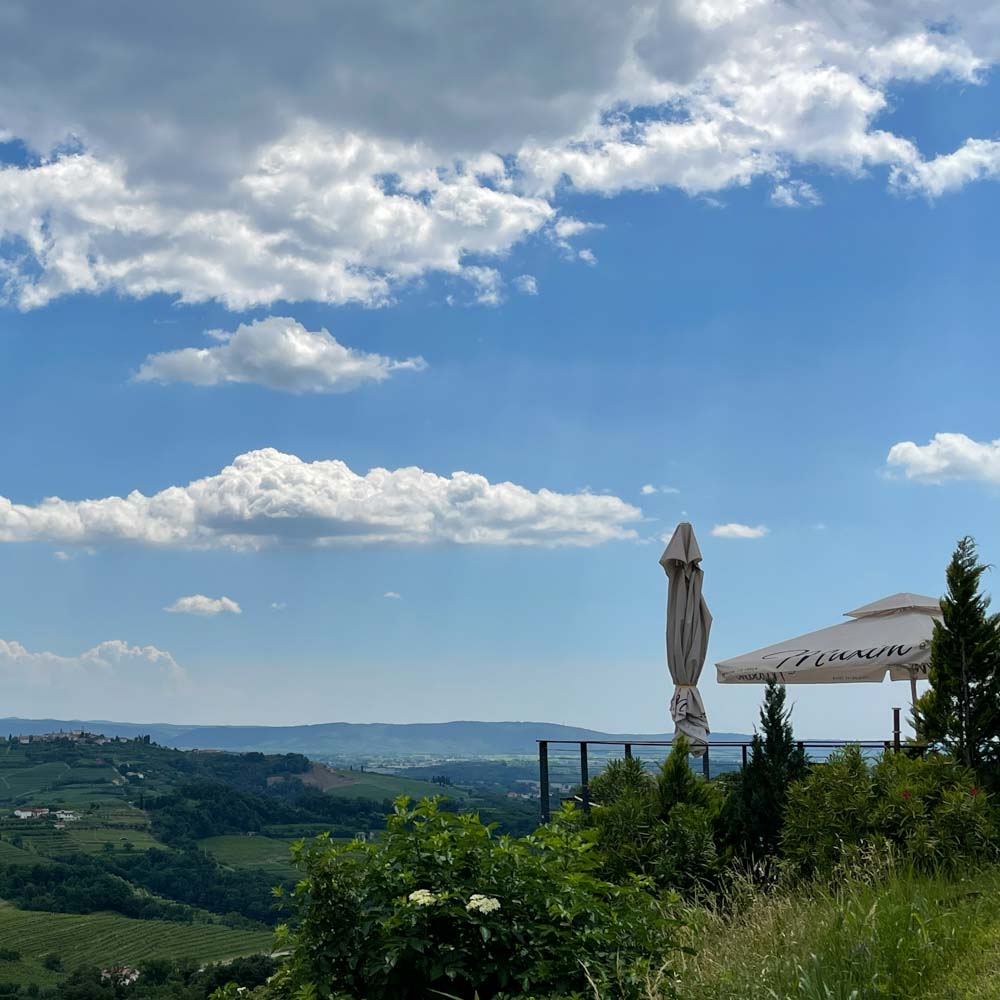
Špica Restaurant and Bar, Lake Bled
Just a few metres from the shores of Lake Bled, this restaurant has a fantastic outside terrace and a lively ambience. The menu begins with an explanation of their culinary philosophy and the importance placed on locally sourced ingredients.
It’s owned by local legend, Jani Klemenčič – a retired Slovenian Olympic rower. If you’re into rowing there’s some fantastic memorabilia inside!
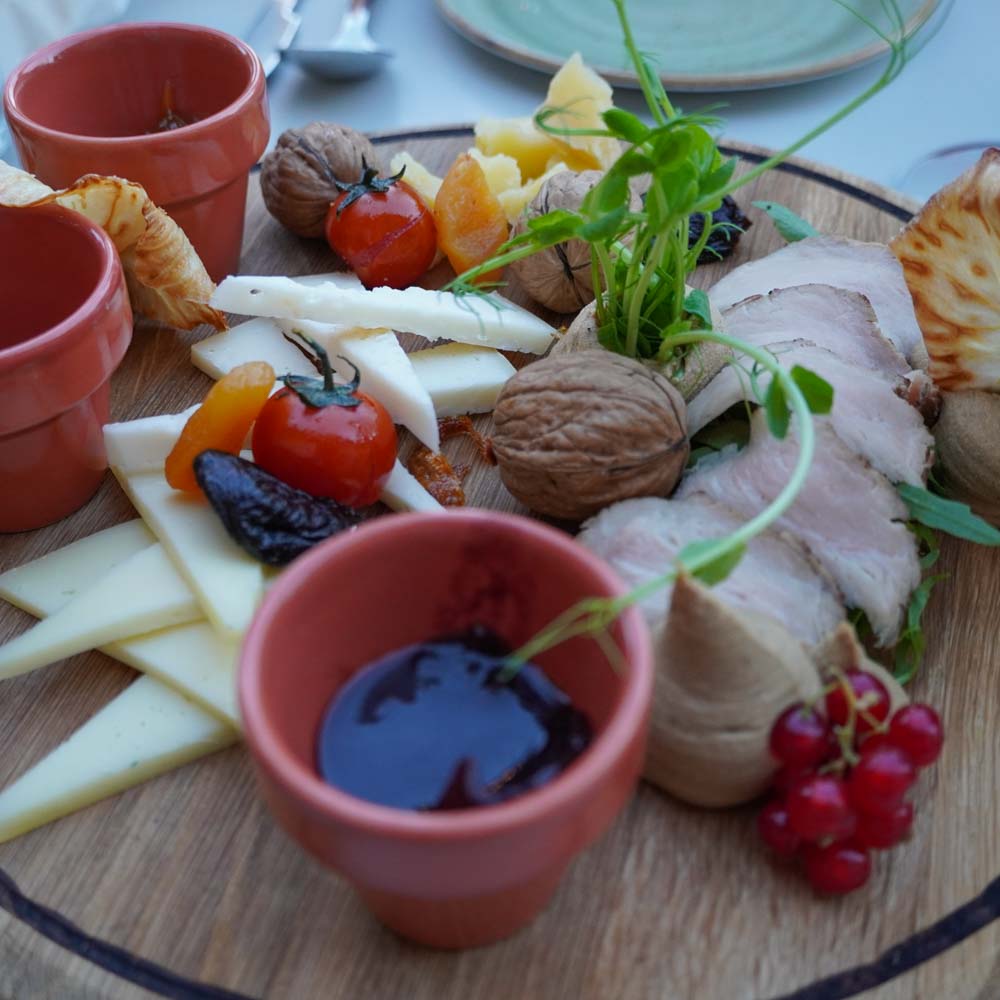
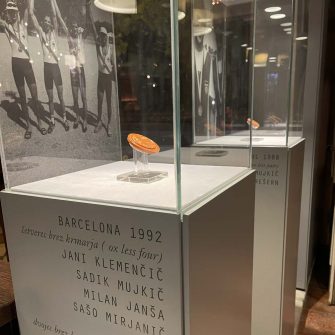
It’s worth noting that we turned up in cycling kit at Restaurant Triglav Bohinj and Hotel San Martin and felt absolutely comfortable, despite them both being quite smart establishments. In terms of local delicacies, meat lovers should try the Slovenian sausage or kranjska klobasa. The frika omelette is a simple but tasty delicacy you’ll find everywhere, with potatoes, egg and cheese. The delicious kremna rezina (a vanilla or custard pastry slice) is commonly associated with the town of Bled.
We also enjoyed some delicious pastries from a bread shop in Granjska Gora – apples, summer fruits, cinnamon, filo pastry seemed to be common themes and everything we sampled was delicious…
Getting to Slovenia
Most international visitors will arrive in Slovenia via Ljubljana’s Jože Pučnik Airport, a refreshingly small airport that we found efficient and easy to navigate. Trieste Airport on the Italian Adriatic Coast is also barely an hour transfer, for example, offering an easy transfer by car or train.
Bikes can be transported on domestic trains and some international trains for a fee.
Slovenia is well connected to its four neighbours (Austria, Croatia, Hungary, Italy) by road and rail. There are many border crossings, both large and small, that allow access to the Julian Alps.
Enjoyed our guide?
We’d love to hear from you – comment below or drop us a line.
- Don’t miss our other in-depth guide to Slovenia’s Vipava Valley.
- Want to check out some other destinations? Check out our pick of the best cycling destinations in Europe or find some other great summer cycling tour destinations. Alternatively you can browse all our guides, search by the month you want to travel or cycling destination you want to visit, here.
- Looking for sustainable cycling holidays? Finally, if you like Slovenia because of its excellent eco-friendly credentials, don’t miss our article on eco-friendly cycling holidays.
Please support Epic Road Rides
A huge amount of time and effort goes into the article you’ve just read, all with the aim of helping you!
If you found what you’ve read useful, I’d really appreciate it if you dropped something in the tip jar here.
It’s a way you can say thank you and help us carry on creating top quality content with no annoying ads and no pay wall.
Looking for an organised cycling trip?
If you want someone to help you plan and book your cycling holiday, fill out this form. We aren’t a tour operator/agent but we work with lots of people who are and will do our best to put you in touch with someone that can help (within 24 hours wherever possible)!
The contents of this website are provided for general information purposes only. It is not intended to amount to advice and you should not rely on it. You should carry out your own due diligence and risk assessments and take professional advice. Views expressed by interviewees or other users of this website do not necessarily represent our views. We make no representations, warranties or guarantees, whether express or implied, that the content on our website is accurate, complete or up to date. If you use any information or content on this website, download from, or otherwise obtain content or services through our website, it is entirely at your own discretion and risk. Epic Road Rides Ltd disclaims all liability and responsibility arising from any reliance placed on the information and content on this website. Find out more here.

